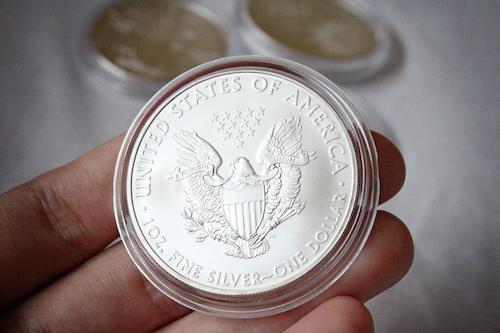
Is Silver a Bargain as Gold:Silver Ratio Approaches 80?
One of the silver investors’ guides is to keep a close watch on the Gold:Silver Ratio (GSR), which has ranged from a low of a little over 30 to a high of around 84 within the past ten years. The ratio effectively represents the number of ounces of silver it takes to buy an ounce of gold based on the relative metals prices at the time – and currently the GSR is getting close to upper end of the ratio at a around 79. Indeed it almost reached 80 at one time last week. The higher the silver price vis-à-vis gold, the lower the ratio.
Real silver bulls always talk about the GSR coming down to its ‘historic’ level of around 14 to 16, but to this writer that is very much wishful thinking. Ever since silver was effectively de-monetized in the late 19th/early 20th Century, the only time the GSR has fallen as low as this was when the Hunt Brothers tried, and nearly succeeded, in cornering the silver market in 1979/80 in an exercise which might now be considered illegal, and at that time the rise in the silver price which set the ratio so low was both meteoric and extremely short lived.
Apart from the wishful thinking and historic level element, promoted by some investors and advisers, the reasons behind the thinking that the GSR should be quite so low often tend to revolve around the comparative rarity of the two metals in the earth’s crust – suggesting a ratio of around 20:1 might be appropriate – or perhaps of the silver to gold production ratio – currently around 9 to 1, but this is purely spurious reasoning. On this basis even rarer metals like platinum and palladium would command prices hugely in excess of where they are now. It is very much investment and industrial demand which calls the tune. When silver and gold were both money there would have been a natural conversion ratio between the two principal precious metals, but arguably this just doesn’t exist any longer.
In the writer’s view a GSR of around 60 to 65 – the approximate average over the past few years – might be a more realistic level, which would put the silver price at about $19-21. This would make the current $15 level a real bargain – even more so should the gold price recover to $1,300 or higher as we would expect.
Gold is having a fairly torrid time at the moment and silver even more so. The former’s price has dropped below $1,250 for the first time since July, although is still up around 8.5% year to date in US dollars which is a reasonable performance under most investment scenarios, and certainly keeps it ahead of U.S. inflation. Silver, though, is down around 3% year to date and is thus underperforming, but seemingly without a specific reason for doing so, except perhaps for a lack of retail and institutional investment demand in the West as demonstrated by the very poor sales of silver coins this year.
In pure commodity terms global silver demand remains positive while mine supply has, if anything, been falling. According to the Silver Institute which publishes research from one of the top precious metals consultancies – GFMS from the UK - supply has moved into surplus for the first time in 5 years, but industrial demand is strong and rising. Notably Chinese demand has been picking up well and is comfortably ahead of the 2016 level already. As the world’s biggest metals consumer this bodes well for silver demand going forward. Germany’s Commerzbank analysts thus believe that silver supply could well move back into deficit in 2018. They predict a rising gold price on ongoing geopolitical and geo economic uncertainty next year and that silver will outperform with the GSR coming back a little, although perhaps not by as much as the scenario we are painting.
What is apparent is that the silver price is being held down by huge short positions on the COMEX silver futures exchange. Some estimates put short positions in silver held by banks and traders, of which JP Morgan and Scotiabank both hold an enormous share, at around the equivalent of over 6 months of global silver production. Interestingly some of these big investment banks – particularly JP Morgan - are reckoned by seasoned analysts to also hold huge amounts of silver bullion in their own and client accounts which suggests that at some stage they may cover their shorts and start to drive prices up again – potentially an extremely profitable move for the big silver holders.
Recent reports also claim that Goldman Sachs is building up positions in silver bullion which, if correct, could be a further sign that perhaps silver’s recent poor performance vis-à-vis gold could shortly be reversed. Or indeed it could be a sign that the whole precious metals complex is due for a major price surge.
Another indicator that things may be about to change is that the latest Commitment of Traders (CoT) report released by the US Government’s Commodities Futures Trading Commission (CFTC), saw an enormous one week reduction in the short positions for both gold and silver – bringing silver shorts down from the equivalent of 7 months global supply to the aforementioned 6 months. That is a huge change to have taken place over a single week and has taken seasoned followers of the big banks’ and traders’ positions completely by surprise. No doubt the current week’s CoT report will be watched with particular interest by observers of the silver market. As noted, the silver price had been forced downwards by futures trades, even more than the recent decline in the gold price but it is particularly interesting that at the end of last week, when gold continued to fall silver actually moved upwards – an unusual pattern in a falling gold price scenario.
This week the sees the latest U.S. Federal Reserve’s Open Market Committee (FOMC) meeting where the Fed seems almost certain to implement another upwards move in U.S. interest rates, probably again by a pretty small 25 basis points. While this has probably already been discounted in the gold price, or should have been, there could be a further knee-jerk fall on the announcement, although one suspects there could be a rapid recovery thereafter as we approach the New Year and enter it – January tends to be a good month for precious metals. This could prove to be the prelude to another upwards phase in the gold price, and this time silver will probably do what it normally does when the gold price is on and upwards path and also rise, but even faster in percentage terms.
So although the silver investor has seen some weakness over the past twelve months, a 3% decline in dollar terms can not be considered disastrous, and the potential for a recovery looks ever stronger the higher the GSR goes. In the writer’s view investing in bitcoin is fraught with dangers given its volatility – although it certainly would have been hugely profitable year to date. Palladium, easily the best performing precious metal this year, may well have run its course given it is now more expensive than platinum which could prompt reverse substitution in the primary autocatalyst market. And longer term platinum group metal prospects are shaky anyway as electric vehicles eat into the auto market.
Thus gold and silver probably still remain the best wealth protection insurance and holding some bullion in an easily accessible place against a major financial meltdown looks to be a prudent move. After all, given the worst case scenario, although perhaps unlikely to happen, it may just not be possible to turn equities, or bitcoin, or even precious metals held in bank vaults at home or overseas, into readily exchangeable assets to see you through a really severe financial crisis.









